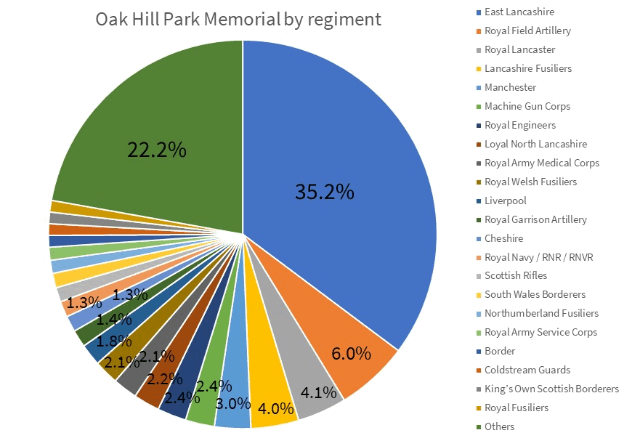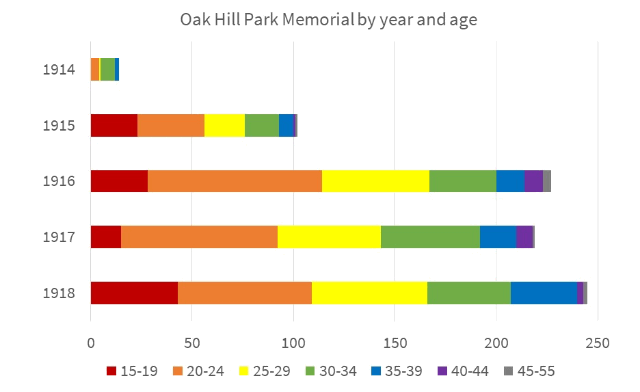 A substantial upgrade to the biographical notes on men named on the First World War memorial in Oak Hill Park, Accrington was completed in November 2020. The work enabled the home addresses of 854 men to be plotted on a Google map that is embedded below; clicking on the icon in the top-right corner will open a larger map which enables searching by (for example) name or street. (The map may not be accessible on Android/iPhone/iPad devices. In this case, the same map can be found as part of the Mapping Loss project.) A substantial upgrade to the biographical notes on men named on the First World War memorial in Oak Hill Park, Accrington was completed in November 2020. The work enabled the home addresses of 854 men to be plotted on a Google map that is embedded below; clicking on the icon in the top-right corner will open a larger map which enables searching by (for example) name or street. (The map may not be accessible on Android/iPhone/iPad devices. In this case, the same map can be found as part of the Mapping Loss project.)
The war memorial that stands today in Oak Hill Park has its origins in a meeting held on Monday 16th December 1918 to appoint a committee to raise a fund for erecting a permanent memorial to the fallen heroes of Accrington. It seems that Oak Hill Park was by no means the preferred location of many for the memorial. At a meeting of the Committee on 6th February 1919, Sir George Bullough and many other members were reportedly in favour of a proposal which involved demolition of the block of property facing the Town Hall, thus opening out a huge square up to St. James’ Church, and the erection of a magnificent monument in the centre. No decisions were taken after a meeting which lasted nearly two hours. By the end of November 1919 it had been decided instead to erect a "stately monument" in the "beautiful and peaceful surroundings" of Oak Hill Park, and a Fund was opened to raise £10,000 (the equivalent of £360,000 today), of which at least £5,000 would be required for the monument alone. Considerable disagreement as to the siting of the memorial in the park rumbled on well into the following year, as did the question of whether the names of the fallen could be inscribed on the memorial. By the end of July 1920, the Committee had commissioned Charles Herbert Reilly to design the memorial, and had agreed that provision would be made to record the names of the fallen in alphabetical order and without distinction of rank. In the following February, the Town Clerk began to advertise for relatives to register the names of those who were either: (1) resident in the borough at the time of joining up; (2) born in, and been immediately engaged in business in the borough, or (3) that their sorrowing relatives reside within the borough. The first sod on the Oak Hill site was cut by the Mayor, Councillor DW Moffitt, on 23rd October 1920. By this time, the Fund had raised £6,500; it was hoped that a further £3,500 could be raised to "help some of the families of those whose great sacrifices they were met to honour." Sculpted by George Herbert Tyson Smith, the memorial was constructed from grey Longridge stone. A tall obelisk, reaching sixty feet from its base, is flanked by pilasters, each surmounted by a representation of flames. In front of the obelisk stands a figure said to represent Maternity mourning for her children. The names of the town’s dead from the Great War were carved into panels of green slate which were mounted onto a long retaining wall in front of the monument. At their meeting on 5th May 1922, the Committee decided on 24th June for the unveiling of the memorial; it was a date without any obvious significance for the town. The explanation for the later switch – almost at the last minute – to Saturday 1st July has been lost in the intervening time, but it would hardly be surprising if the change of date to the sixth anniversary of the opening day of the Battle of the Somme was made at the behest of John Harwood. The new date was fixed "in spite of the clamour in some quarters". There were said to be 15,000 spectators at the unveiling ceremony in the afternoon of 1st July 1922. John Harwood laid the first wreath – in honour of the Accrington Pals – at the foot of the memorial. Henry Hargreaves Bolton, who unveiled the memorial, laid his wreath at the base of the panel which bore the names of his three sons who lost their lives in the war. Once the formal ceremony was over "the bereaved filed past in a seemingly never-ending queue bearing the wreaths to place near the name of some lost one." Intriguingly, a film was taken of the ceremony; described as being "particularly interesting and clear, the features of the relatives carrying their floral tributes, the Territorials, and ex-Service men being as plain as possible", the film proved a "tremendous attraction" when shown at the town's Empire and Prince's Picture House. The fate of the film – owned by Victory Theatres (Accrington) Ltd – is not known. Of the names originally inscribed when the memorial was unveiled on 1st July 1922, and disregarding a number of duplicates and even survivors of the war, 35.2% lost their lives with the East Lancashire Regiment. Other prominent regimental affiliations include the Royal Field Artillery (6.0%), among which were men of the 158th (Accrington & Burnley) Brigade, King's Own (Royal Lancaster Regiment) (4.1%), Lancashire Fusiliers (4.0%) and the Manchester Regiment (3.0%). Perhaps surprising to many is that only 14% could be regarded as "original" Accrington Pals, those who joined the battalion between September 1914 and January 1915.  Above: Accrington men who lost their lives in the First World War and who are named on the memorial in Oak Hill Park - breakdown by regiment. The impact of the opening days of the 1916 Battle of the Somme on the town of Accrington is very obvious from the chart below, yet this was not solely attributable to the losses suffered by the Accrington Pals; 38% of the fatalities of July 1916 came from other units. Also noteworthy is that the number of fatalities in 1916 was almost met in the following year, and exceeded in the final year of the war.  Above: Accrington men who lost their lives in the First World War and who are named on the memorial in Oak Hill Park - number of deaths by month. The first to lose his life in the war was 31-year-old Private Walter Harry Withall, a police constable with the borough police force, killed in action with the Queen's Bays at Nèry on 1st September 1914. The last to be killed in action was 21-year-old Eldred Terrill Towler (1/5th East Lancashire) at Forêt de Mormal on 6th November 1918.  Above: Accrington men who lost their lives in the First World War and who are named on the memorial in Oak Hill Park - number of deaths by year, broken down according to age at time of death. The youngest to die was 15-year-old Private Robert Harold Cunliffe, born on 30th November 1899 and killed in action in the Gallipoli campaign on 22nd September 1915 with 6/East Lancashire. The oldest to lose his life was 55-year-old Private James Barnes who died of dysentry on 16th May 1916 while serving with the 8th South African Infantry Regiment in East Africa. © Andrew C Jackson 2021 |